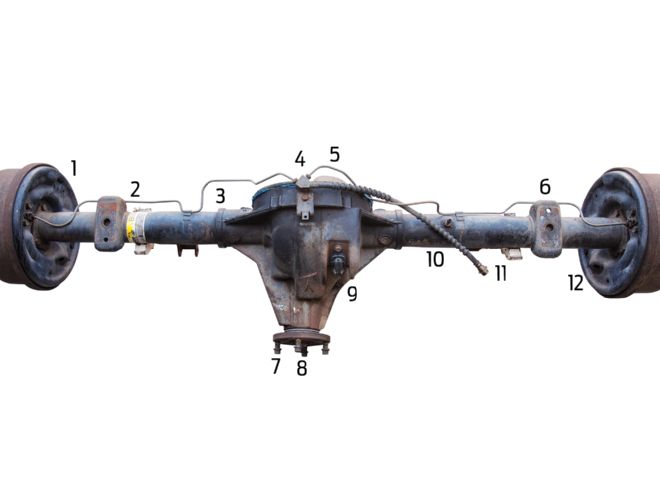
1] Some 1986–1993 Mustangs had disc brakes. All SVO Mustangs had five-lug disc brakes, then in 1994, most Mustangs had rear disc brakes.
2] On earlier vehicles, the ID tag is bolted to the diff cover, though they are often missing. Ford started phasing out the metal tags in the late ’80s, replacing them with a sticker located on the axletube by the brakes.
3] The axletubes have been known to turn inside the housing, as they’re held into the third member by just two plug welds, seen here. Use nickel rod and weld the tubes all the way around where they enter the housing.
4] Many models included a Traction-Lok limited-slip differential, which can be identified by a large, S-shaped clip pressing against the inside of the side gears. This can be seen only with the cover off; without an ID tag, you can’t spot a Traction–Lok from the outside.
5] Plastic covers are occasionally found on ’90s Rangers and Explorers.
6] Fox-body 8.8s have coil-spring perches and tabs for the control-arm bushings. Only truck versions have leaf-spring pads.
7] From the factory, 8.8s use 1330- or 1310-series U-joints. This is the companion flange where the yoke bolts. The 1330 has a 33⁄16-inch width for the U-joint, and the 1310 has a 35⁄8-inch width. The 1330 is usually found in Ford trucks. The aftermarket sells flanges of various widths for added strength and conversions for Jeeps, all of which fit either the original 1330- or 1310-series universal U-Joints.
8] These rearends generally use a 28-spline pinion yoke, but some trucks use a 30-spline.
9] This is the plug for ABS found on some 8.8s.
10] Most 8.8 axletubes are 3 inches in diameter and very thin. To prevent warping from heat, don’t use a torch and avoid extended use of a die grinder while modifying an 8.8.
11] The 8.8 is cheaper than a 9-inch, and if you add 31-spline axles, it can be as strong as a GM 12-bolt. The pinion-gear shaft diameter is larger than on a 9-inch and the same size as on a Chevy 12-bolt.
12] Ranger and Explorer axles have a 5-on-41⁄2-inch bolt pattern. Fox-body axles use a four-lug wheel pattern.
More 8.8 Info
Factory 8.8 Gears Available With Traction-Lok:
2.73, 3.08, 3.27, and 3.55:1
All Factory Ratios:
2.26, 2.47, 2.73, 3.08, 3.27, 3.45, 3.55, 3.73, and 4.10:1
ID Tags:
The ID tag can be your friend. It will tell you the gear ratio, rearend style, and whether it has limited-slip. Also on the tag is an ID number, which, until 1985, included four to five letters, no numbers. Almost all 8.8s—and all post-’86 Ford rearends—have letters and numbers. The first number refers to the plant where it was built, and the next three refer to the ratio and type. The numbers can also tell you what car the rearend came in, though you need to look up the info online or in a Ford manual, as there are thousands of codes.
Quick Facts
First appearing in 1977, the 8.8 is found in almost all Ford V8 cars from ’86 on, and in V6 Rangers and Explorers. There are 24 different Fords that offered the 8.8 rear axle.
The weakest points of the 8.8 are the 28-spline axles (1.18 inches in diameter). The 31-spline axles (1.29 inches in diameter) are more desirable but far less common. You can buy aftermarket 31-spline axles, but that will also require a new carrier and side gears. Most ’91–’01 Explorers have 8.8s and 31-spline axles.
Most 8.8s have offset pinions, but 8.8s in Mustangs have axles that are the same length side to side. The ’86–’93 Mustangs have 29.063-inch axles, and the rearend is 59.25 inches from axle flange to axle flange. The ’94–’98 axles are 0.75 inches longer (the rearend is 1.5 inches wider overall). The ’99–’04 is another 0.75 inches longer (the flange-to-flange width is 3 inches wider than with ’79–’93 Mustangs)
The 8.8 is a C-clip rearend, which is a major weak point because if you break an axle, it can come out of the housing, and you’ll lose the wheel and probably quarter-panels while you’re at it. The aftermarket sells C-clip-eliminator kits that retain the axles with flanges at the ends of the axletubes.